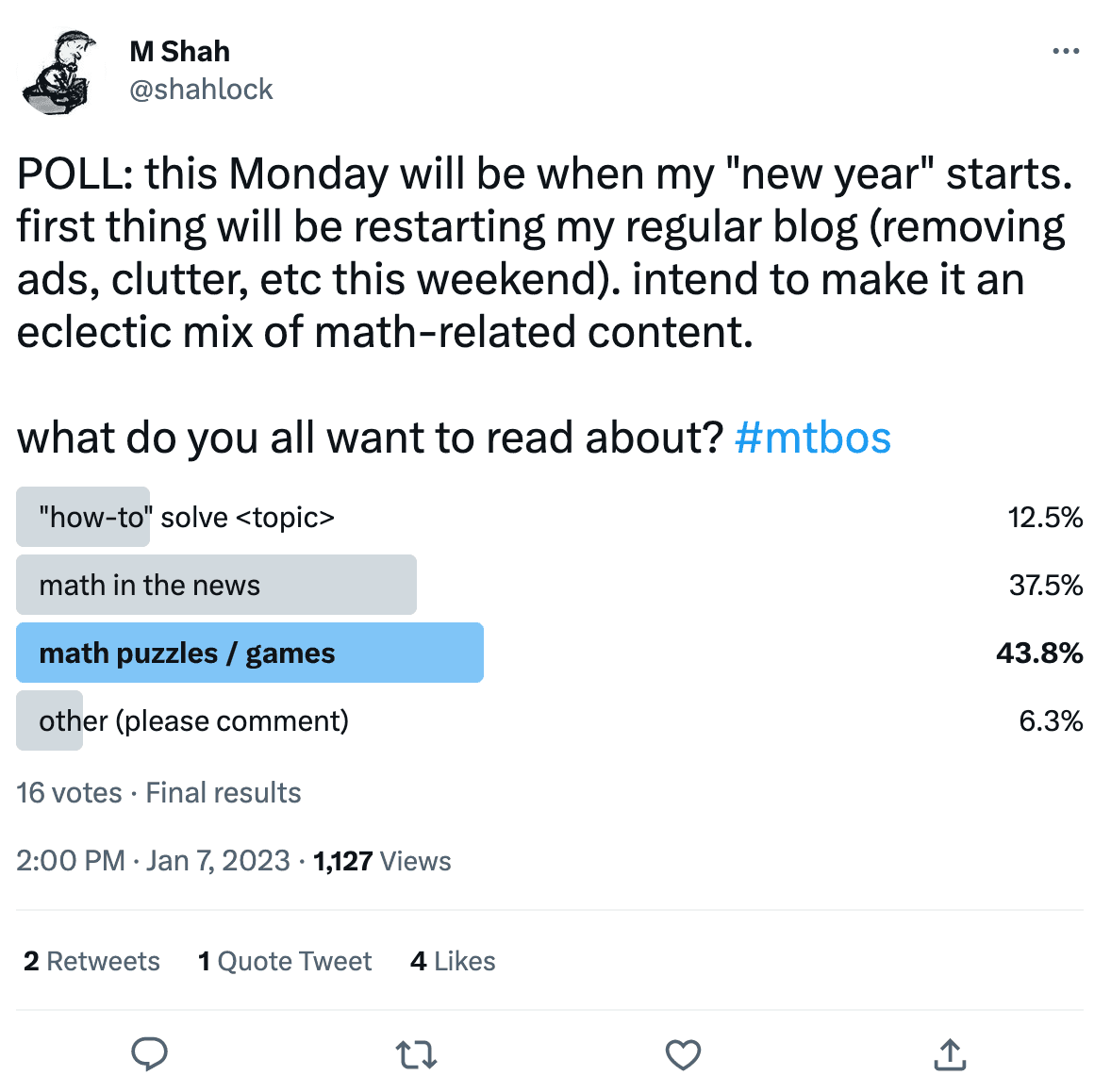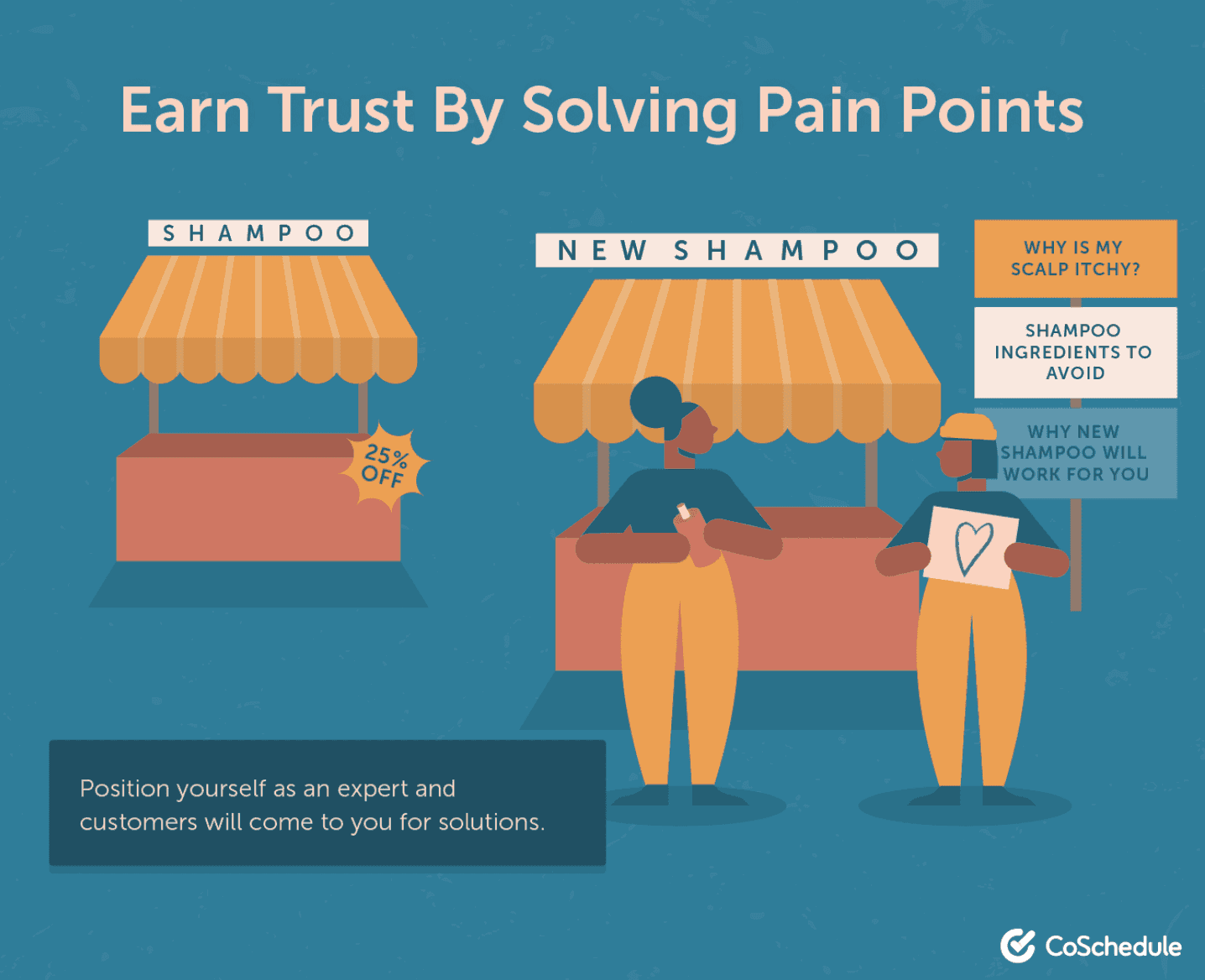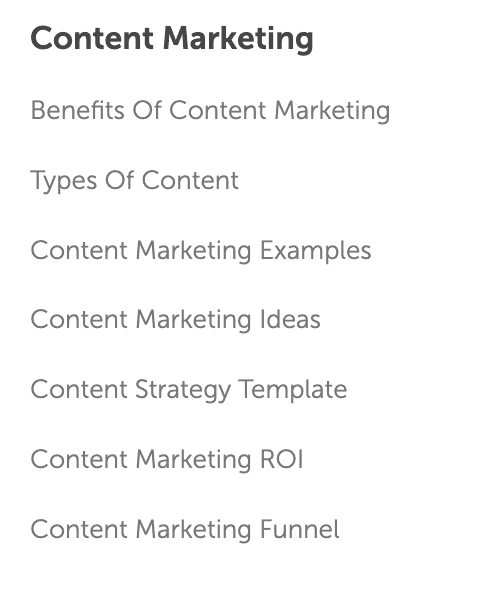Ever wrack your brain for content ideas and come up with… nothing?
It’s a pretty common challenge for marketing pros. In fact, I had to sit and think for a little while to put together the right introduction for this blog post! To be honest, creative blocks are more a part of the process than the exception.
If a creative rut is simply a step in execution, how do you get to the next step of overcoming that block?
It turns out that many marketers have go-to strategies for when they can’t come up with a topic. They don’t do it alone, and you don’t have to, either.
We put together these 43 content ideas for your next marketing project to keep your creative process moving. Many of them involve methods that you can reuse over time, so you’ll have a technique to turn to when you run out of ideas.
Recommended Reading:
- 218 Creative Blog Post Ideas That Will Delight Your Audience
- Digital Marketing Agency: How To Win The Name Game
- Idea Generator
But first, before you go on, make sure you download your free content marketing strategy template.
1. Build On The Basics
Your content ideation journey should start with the foundation — your product or service. As you review your main offering, you might find inspiration right in front of you.
If you still feel stuck, exploring modern tools can help kickstart creativity. This G2’s expert curated guide on AI writing generators shows how marketers use AI to brainstorm, outline, and draft ideas more efficiently. As experts note, “Leading AI writing generators commonly use modern LLM to deliver human-like text, cone control an summarization.”

If you don’t know the answers to these questions with the data you have, try performing some fundamental marketing research techniques to collect information on your audience. The information you’ll get from your research will make a great reference when you need details on your customers.
2. Look At What Others Are Writing About—& Do A Better Job
You probably already have a list of blogs and publications that you look up to and hope to emulate one day.
Why not start emulating them right away?
Have a look at their top posts, and come up with similar ones, but better. There’s a reason why these blog posts did well for them, and if your target audience overlaps with theirs, you can be sure that this will be a win.
Backlinko’s Brian Dean calls this the skyscraper technique. Here are four ways that you can make your post superior to the original (Thanks, Brian!):
- Make it bigger or longer: Go for broke, and find 100 ways to help your audience instead of just 50. Making a comprehensive guide gives your audience a one-stop solution for what they’re searching for, shows your expertise, and builds your credibility.
- Make it more up-to-date: A list post that did well in 2015 will likely do well again in 2016, and the year after, and so on. Build on what you know already works with your more recent knowledge.
- Make it look nicer: An infographic that visualizes text content that resonated with readers will certainly attract more attention. Heck, infographics are some of the most-shared types of social media content, and content with visuals included about every 100 words can grow your shares by 30%.
- Make it far more detailed: 100 bullet points will never compete with 100 points with brief descriptions.
Our CEO and co-founder Garrett Moon broke down how to use the technique in this blog post.
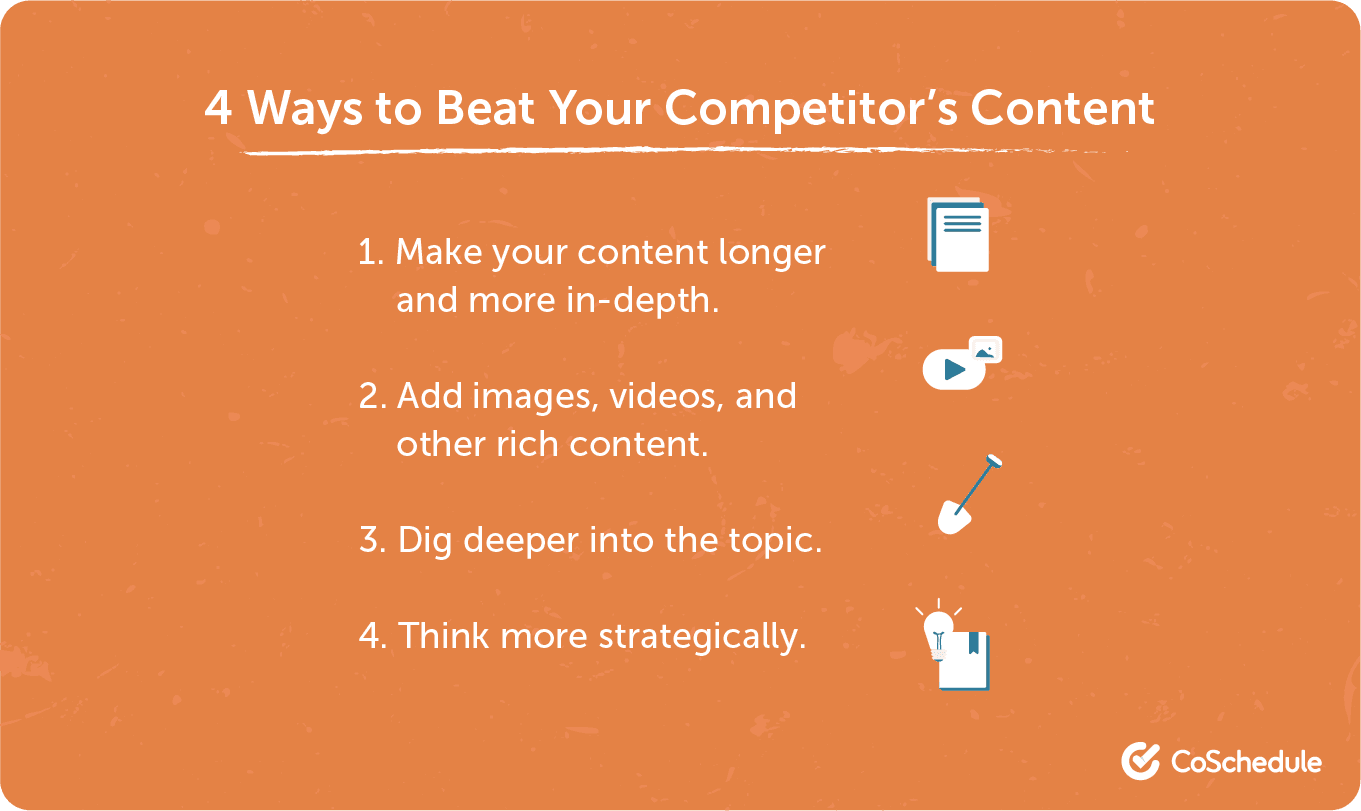
3. Listen To What Your Customers Are Asking About
Think that it’s hard to come up with content marketing ideas for your niche? Try doing it for a pool company, and you’ll realize the true meaning of hard.
Yet back in 2009, Marcus Sheridan’s company River Pools and Spas was able to use content marketing to dominate the pool industry. His solution for coming up with topics is exceedingly simple: To answer his customers’ questions.
“The problem in my industry, and a lot of industries, is you don’t get a lot of great search results [online] because most businesses don’t want to give answers; they want to talk about their company,” he said in an interview with The New York Times.
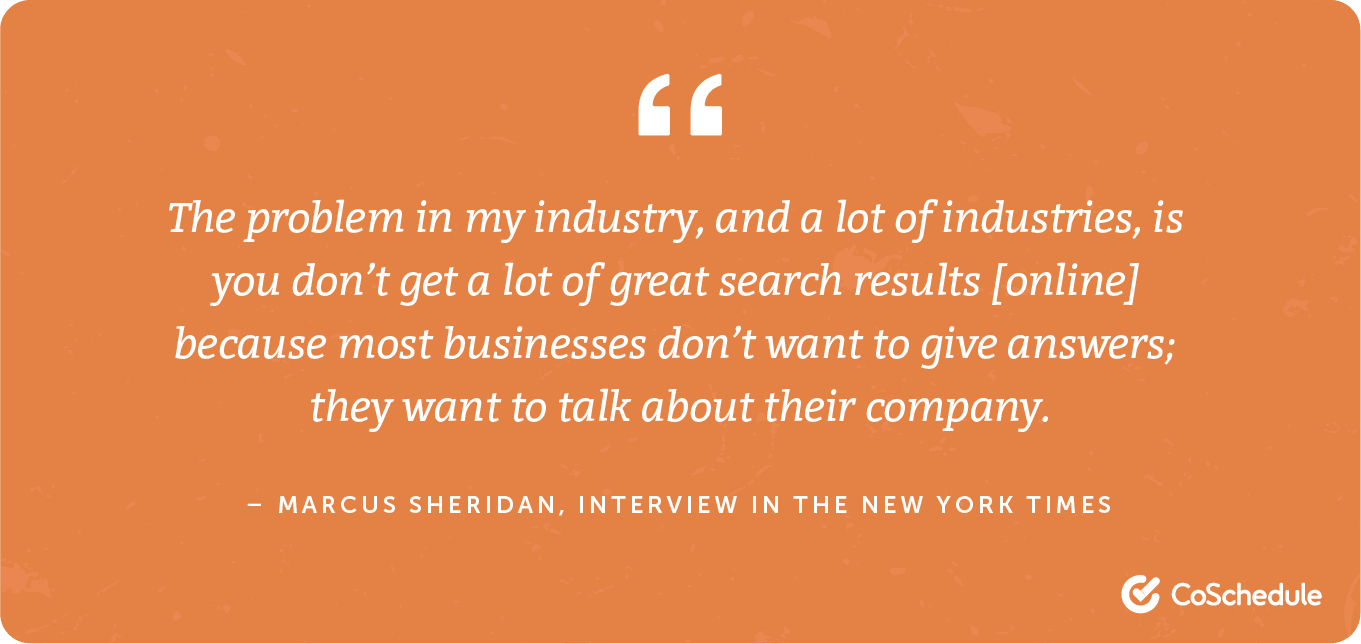
“So I realized that if I was willing to answer all these questions that people have about fiberglass pools, we might have a chance to pull this out.”
When brainstorming with his clients over at his online marketing consulting business, The Sales Lion, Marcus reveals that he has “never had a company come up with less than 100 questions in 30 minutes.”
There are a number of ways to find out what your customers are asking about in your industry and business.
4. Ask Your Email Subscribers
A marketer with an email list has a valuable source of content topics at their fingertips. Since your list of email subscribers often overlaps with your list of content readers, they can provide ideas that your audience will care about. You just need to know what questions to ask them.
When you want information from your email list, you have two main methods of obtaining it — a single-question poll or a survey. A quick poll needs less commitment from your subscribers than a full survey, but it will obtain less detailed information. Meanwhile, a survey is a bigger ask of your subscribers, but it’ll give you richer information.
You can read our guide to marketing research strategies and HubSpot’s Ultimate Guide to Surveys for help thinking of questions. These resources will help you create concise questions that will get you relevant answers.
5. Make A Twitter Poll
If you have a decent Twitter following, ask for their opinions through a poll. Depending on how many people subscribe to your emails versus how many follow your Twitter, you may also get data from a new audience segment.
According to Twitter’s global creative lead, Joe Wadlington, the right Twitter poll copy will help you get valuable responses. Wadlington recommends keeping polls positive and clear with consistent answers. You may also want to avoid “joke” answers that could skew your results, even if they’re fun to include.
Maybe try out a casual, simplistic poll at first to gauge your engagement levels.
6. Listen To Others In Your Industry
Your customers might be an excellent source of potential marketing ideas, but they might have missed out on a question that others asked.
How do you find out what the rest of the industry is curious about?
Find out where they gather to talk shop. Facebook groups, Twitter chats, and forums are some of the platforms that will bring them all together. It pays to become an active participant, as you can get industry-wide exposure over there.
Another popular platform that attracts questions across a variety of industries is Quora. People visit Quora to ask questions on a wide range of topics — including those relevant to B2C and B2B companies. Using this platform, you can research commonly asked questions from your audience to inspire content that answers them.
To find questions relevant to your readers, you can search topics directly on Quora or through Google. When you search for Quora pages on Google, you’ll see answers according to their SEO ranking, so the results can help you figure out what questions will help you rank higher.

In the example above, I went to the second page of Google results for Quora pages related to tea steeping. I wanted to find relevant questions that I might not think of on my own.
Since results past the first page tend to have a less direct connection to the keyword, they can provide spin-off ideas on your topic.
7. Check Out Relevant Subreddits
Like Quora, Reddit has plenty of curious users ready to learn about various topics, but it has a community focus over a question-and-answer focus. Subreddits, the different communities on Reddit, cover broad topics, like gaming, and more niche topics, like Star Wars prequel memes. Reddit users also talk about more professional subjects, taking part in active subreddits on fields, like copywriting and engineering.
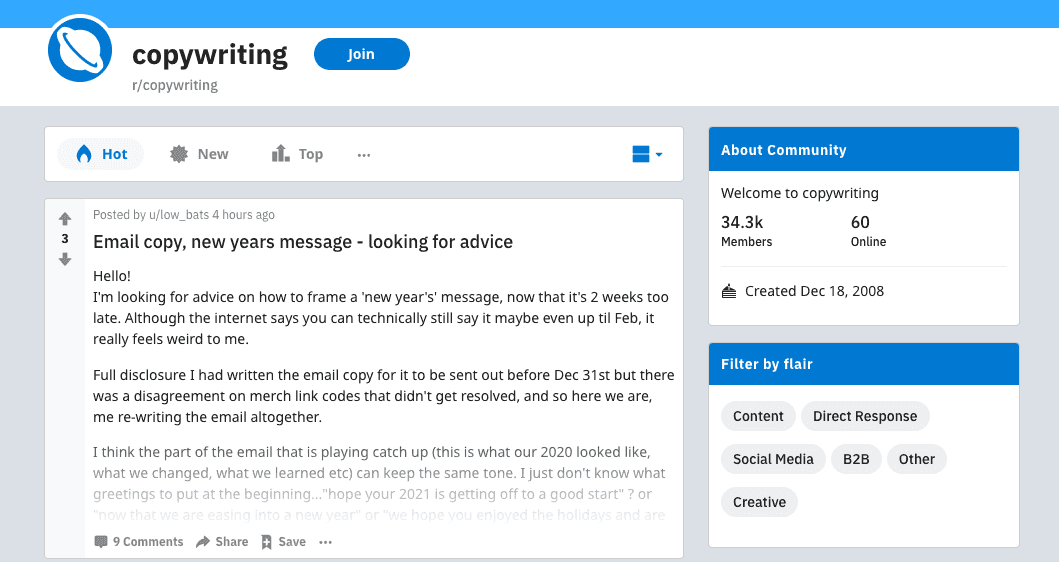
Reddit posts come in the form of questions, memes, links, and discussions — providing insight into what your audience talks about on the internet. Depending on the topics related to your business, the subreddits you come across may also have “megathreads”, where commenters have questions and comments that you might not see as individual posts.
For example, if you want to see how customers shop for personal care products on Boxing Day, the Lush Cosmetics subreddit had multiple megathreads for sales across the world.
8. Leverage The Power Of Social Listening
As Joei Chan explained in our conversation with her on the Actionable Content Marketing Podcast:
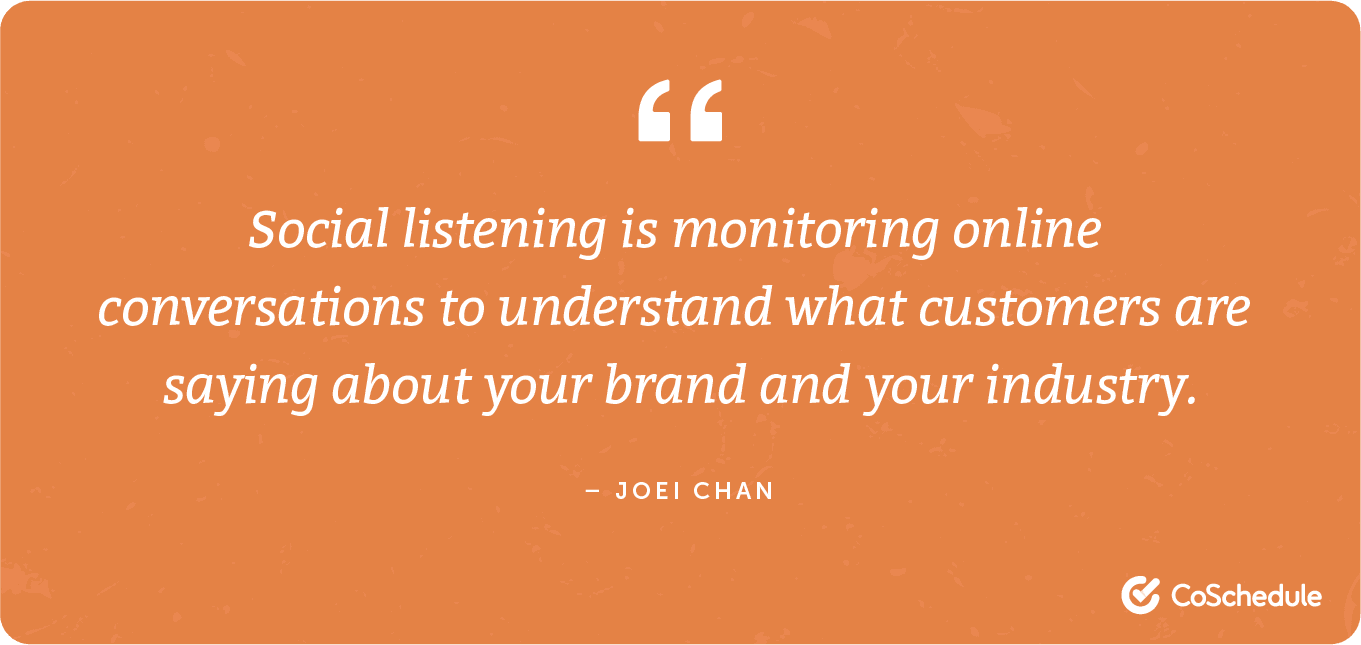
Just like Quora and Reddit research, social listening provides a direct look into what your audience says about your field or product.
Some businesses use a platform, like Mention, to keep an eye on social media conversations, but you can also perform social listening manually. Think of terms and phrases related to your product and industry, then search for them on social media platforms, like Twitter and Instagram.
During social listening, try using basic phrases, like your brand name and more niche phrases related to the topics you cover.
Going off of our previous tea steeping example, perhaps your product is a tea strainer. You would search for your product’s name as well as topics, like “how to steep tea” or names of tea varieties.
9. Look At Google’s “People Also Ask” Box
When looking at Google Search results, you might see a box titled “People also ask” that features questions related to your search. Google generates this box based on searches from users who searched the original term.
For example, you’ll see these related questions pop up when you search “how to steep tea”:

As you can see, users also asked questions about the meaning of the word “steep”, whether you have to cover tea while it steeps and if you steep tea while water boils. This box digs deep into what users want to know — providing insight into their thought process during each phase of the customer lifecycle.
10. Research With Google Trends
Where do you turn to find out what people search on Google to find your content? It turns out that Google has a completely free tool to monitor search patterns — Google Trends.
Google Trends has plenty of valuable nuggets of information that reveal what searchers interested in your topic want to know. Let’s switch up our examples and check out the search term for “coffee”.
Each Google Trends results page shows the term’s popularity over the time you specify. The graph ranges from 0 (not enough data) to 100 (peak popularity). As Nick Churick at Ahrefs points out, you can use this data to jump on trends or plan your future content calendar.

You’ll also see the term’s popularity by region:

Below the term’s regional trends, you’ll also find topics and queries that people who search for “coffee” also search:

As you can see, you can have Google rank these terms by “Rising” (recent volume) and “Top” (overall volume). Interestingly enough, when I did my research, people who searched for “coffee” also searched for “whipped cream” and “Pabst Blue Ribbon beer”. How do you think you would create content based on those unexpected topics?
11. Play With Keyword Modifiers
Keywords — words that best represent a concept or item — make great inspiration for content ideas in addition to their main use in SEO. According to our keyword research guide, a keyword consists of a core term and modifier. By trying out different modifiers, you can find new angles for your content and rank for more search terms.
To create new ideas with this technique, start with a basic topic to use as the main keyword, then add a new angle to it through a modifier.
Try adding these modifiers to your topic to see what you come up with:
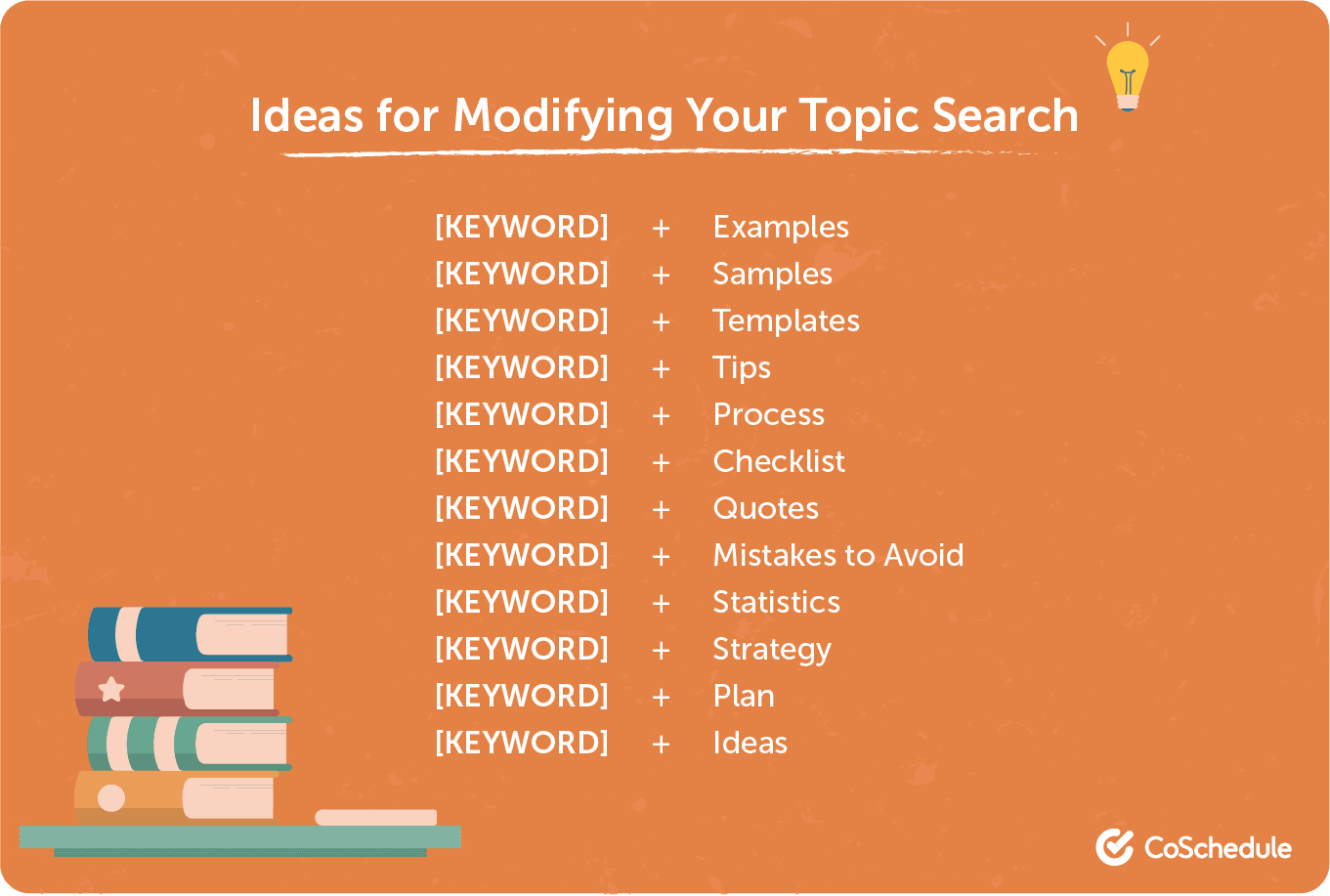
12. Interview Industry Rockstars
Every industry has its rockstars. Startups have Elon Musk. Designers have Jony Ive. And marketers have Seth Godin.
And their success and experience make them a treasure trove of tips, tricks, and advice—things that your readers are dying to learn.
To get the most from them, it’s important to know them well first. Here’s where a little journalistic inquiry will come in handy. First, find out what their stories are, and what is so extraordinary about them.

Look for marketing tips and think about what your readers can learn from them like Lifehacker did when they interviewed Seth Godin on the mentality marketers should have when coming up with a marketing strategy. Come up with topics accordingly.
What is their secret to being so productive? How can they do what they do so darn well? What are some of the greatest mistakes they’ve made?
Connect their expertise to what you know your audience will dig, and you’ll have a winner.
13. Be Authentic
Okay, that sounds like fluff, but hear me out.
People love stories. It’s built into us—we can’t help but look for the story in everything. This is because it’s “a way for humans to feel that we have control over the world.”
And you are most uniquely qualified to talk about your own stories. I don’t mean for you to make up fictional tales.
Talk about your journey, struggles, and opinions. For example, what are your goals, and how are you trying to achieve them? Groove’s Alex Turnbull managed to build out a popular blog out of their singular mission: To reach $100,000 (and now $500,000) in revenue.

Think that you have nothing worth sharing? Everyone does, according to John O’Nolan from Ghost:
“These posts aren’t just an exercise in narcissism, they can be incredibly useful for other people in your industry. Everyone has to start somewhere, and by learning from your mistakes the next generation can progress even quicker.”

Companies like Buffer and iDoneThis have also dedicated whole blogs to telling the inside story.
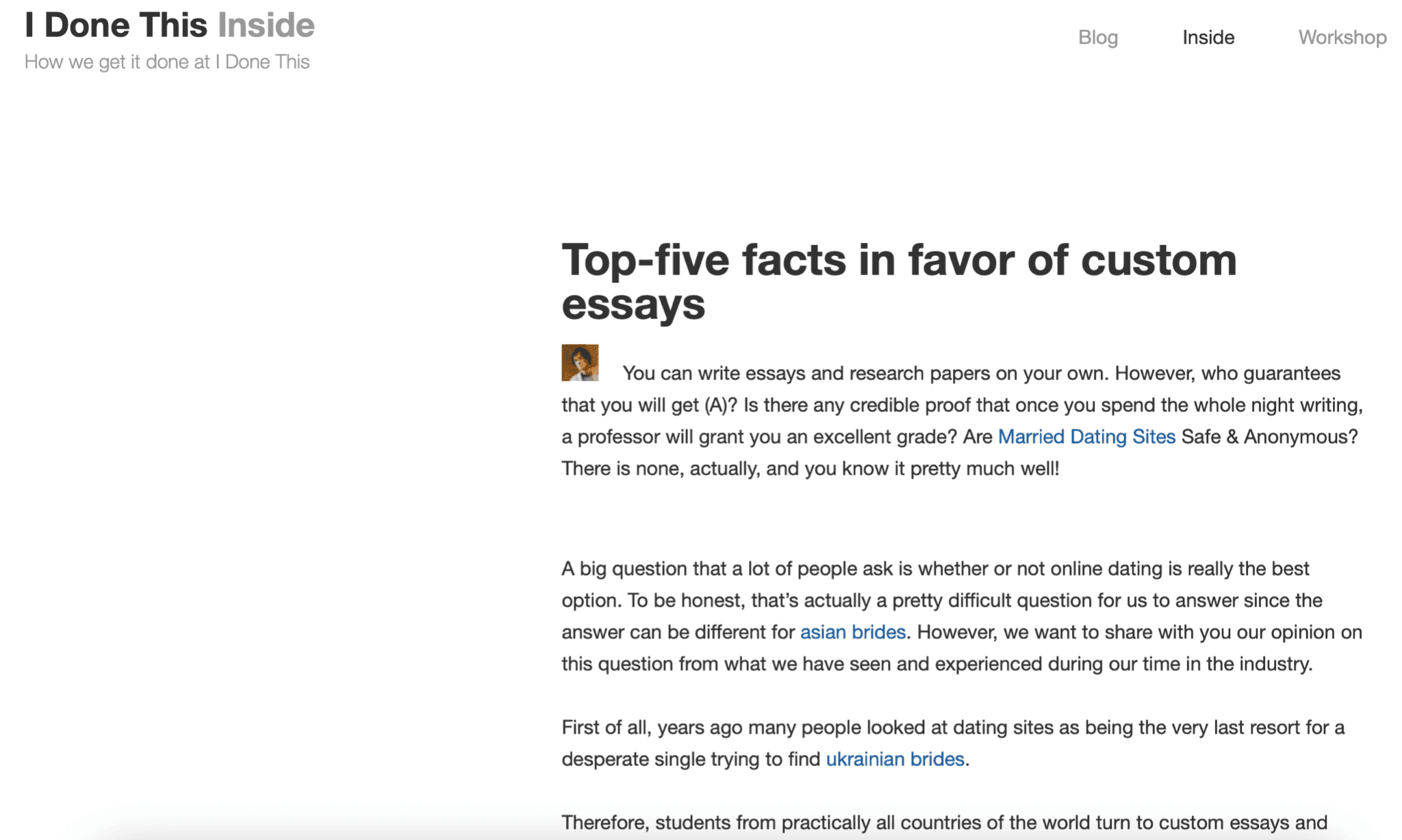
Put the spirit of point 1 into action (publish better content than anyone else), and have a look at what kind of topics these example companies tackle—they could apply to you, too.
14. Work With Your Customer Service Team
Customer service professionals hear customers’ problems firsthand — making them a great source for researching customer pain points. Pain points are the problems that your customers have as they look for, buy, and use a product like yours. Once you know your customers’ pain points, you can offer tailored solutions through your content.
Since pain points come up through all stages of the customer lifecycle, they’ll give you plenty of inspiration for topics related directly and indirectly to your product. You’ll be able to generate ideas for solving problems with your product or addressing issues found during the customer experience to make your readers’ lives easier.
15. Talk To Your Sales Staff About Objections
In addition to getting in touch with your customer support team, you should contact your sales team for inspiring insights into your audience. Ask them about the most common objections they hear during the sales process to create topics that address them.
How do you use content to address customer objections effectively? You can turn to HubSpot’s 40 examples as a starter. If your sales staff has experience handling those objections well, you can also learn what answers they use and elaborate on them with your content.
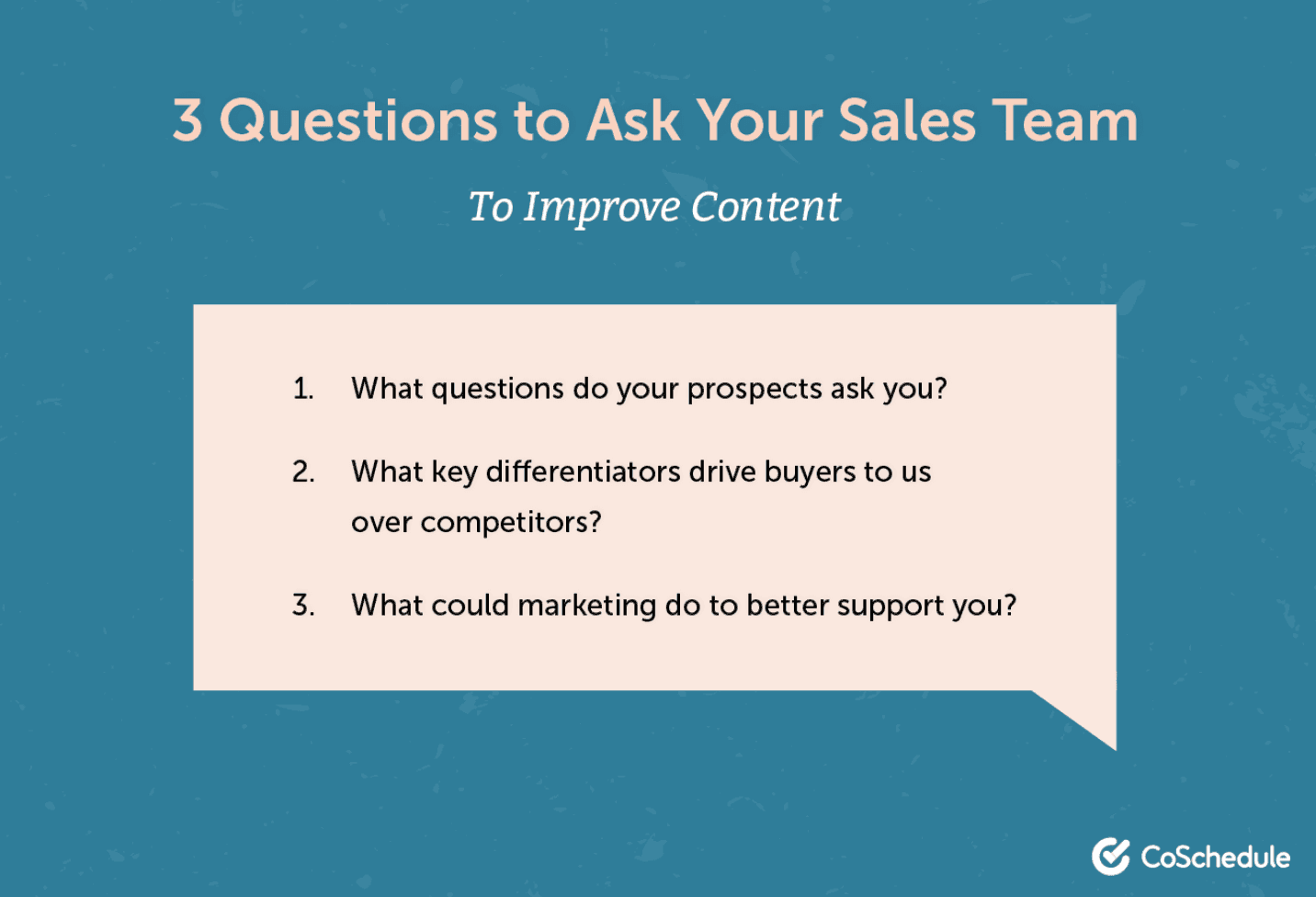
16. Keep Up-To-Date
Every industry has its own set of buzzwords and trends that constantly go in and out of fashion. If you’re quick enough, you can ride these waves and come up with post after post where you can put your two cents worth in.
For example, in May 2020, Google announced a new way they would measure webpages for better user experiences. Many people in the industry have been talking about Google’s Core Web Vitals.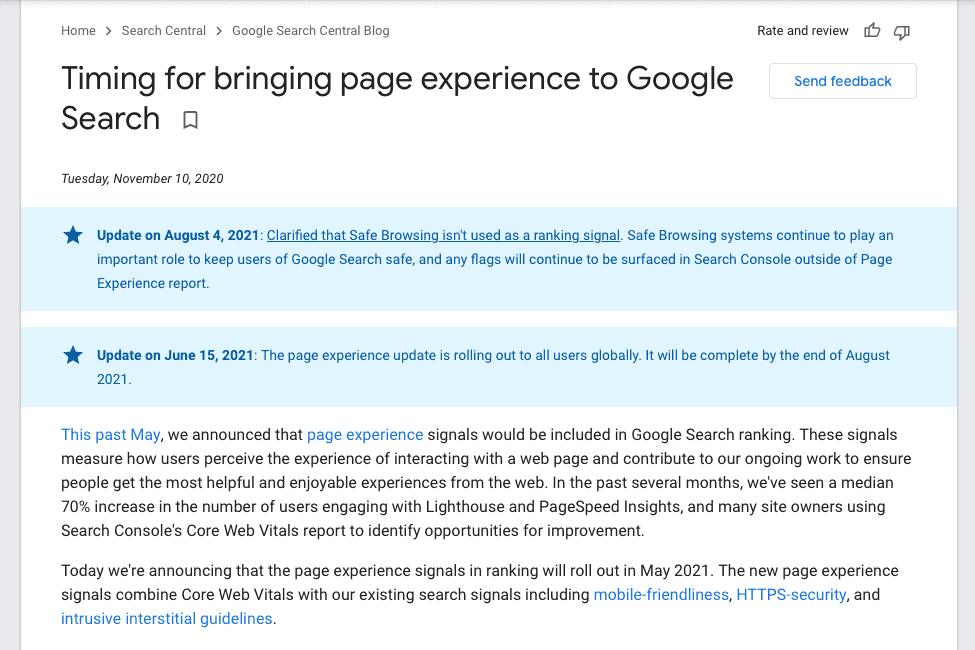
Articles discussing what this means for marketing have been popping up everywhere. Collective Measures did a great job analyzing what people should do to make sure they continue to rank high on SERPs when Google switches processes.
Other articles like this one by Axon Garside go deeper into what Core Web Vitals are and how website owners can check to see if their website is working well enough for these new elements.
17. Read A Book
According to Pew Research, about a quarter of adults haven’t read a book at all in the past year. Why don’t you help your audience keep up with the best reads on relevant subjects?
Try reading a book related to your product and industry and share what your audience can learn from in your content.
18. Conduct A Gap Analysis
Checking what content your competitors are making is a common strategy in marketing, but have you ever tried analyzing what they’re not doing?
A gap analysis evaluates what kind of content your field doesn’t cover, so you can fill those spaces in the media landscape.
19. Bring Your Own Angle To Industry News
If you follow your industry’s news, you already have access to a fantastic resource for content ideas. Consider sharing your thoughts on and responses to the latest happenings in your field, so you can add more content to your website and solidify your thought leadership.
As Rebecca Riserbato at HubSpot puts it, thought leadership is a marketing tactic centered around becoming the go-to expert in your field.
By providing your takes on what’s going on in your industry, you’ll give your audience context they won’t find anywhere else. Plus, you can adapt this strategy to both B2B and B2C audiences.
For example, you can explain to customers how a change in your industry could affect their experience when targeting a B2C audience.
20. Publish According To Seasonal Demand
Remember to pay attention to your customers’ behavioral trends throughout the year to craft content that meets their most urgent needs. Seasonal marketing goes beyond holidays because every business has annual trends to follow.
You can follow seasonal demand with your content by looking for patterns in your business.
Ask yourself the following questions:
- What time of year is the busiest for our business and why?
- When can customers get the most use out of our product?
These principles apply to both outdoor and indoor industries. For example, a lawn care business might create content about preparing your yard for spring in March and April. Meanwhile, an accounting business in America could explore topics related to tax returns around that time.
21. Publish Your Content On LinkedIn Pulse
If you’re looking to give your content a second platform to call home, LinkedIn may be it. LinkedIn Pulse is LinkedIn’s professional blog platform and republishing your content there is as easy as copying and pasting it from its original source.
It is important to note that any content you publish has to be authored by you and only you. If you have multiple writers on your team, only they can publish the content they write.
LinkedIn has a more in-depth overview of how to publish on Pulse in their help docs.
22. Set A Consistent Publishing Schedule
If your team decides that publishing content on a blog or some other source is right for you, make sure that you are sticking to a consistent schedule.
Not only does a consistent schedule set expectations for your audience to find new content at a specific time, but it also holds your team accountable for your deadlines.
Check out this blog post on how to maintain a consistent content schedule.
Once you’ve determined your schedule you can use a tool like CoSchedule to manage your editorial calendar. Our WordPress-friendly platform will help you manage your content from start to finish.
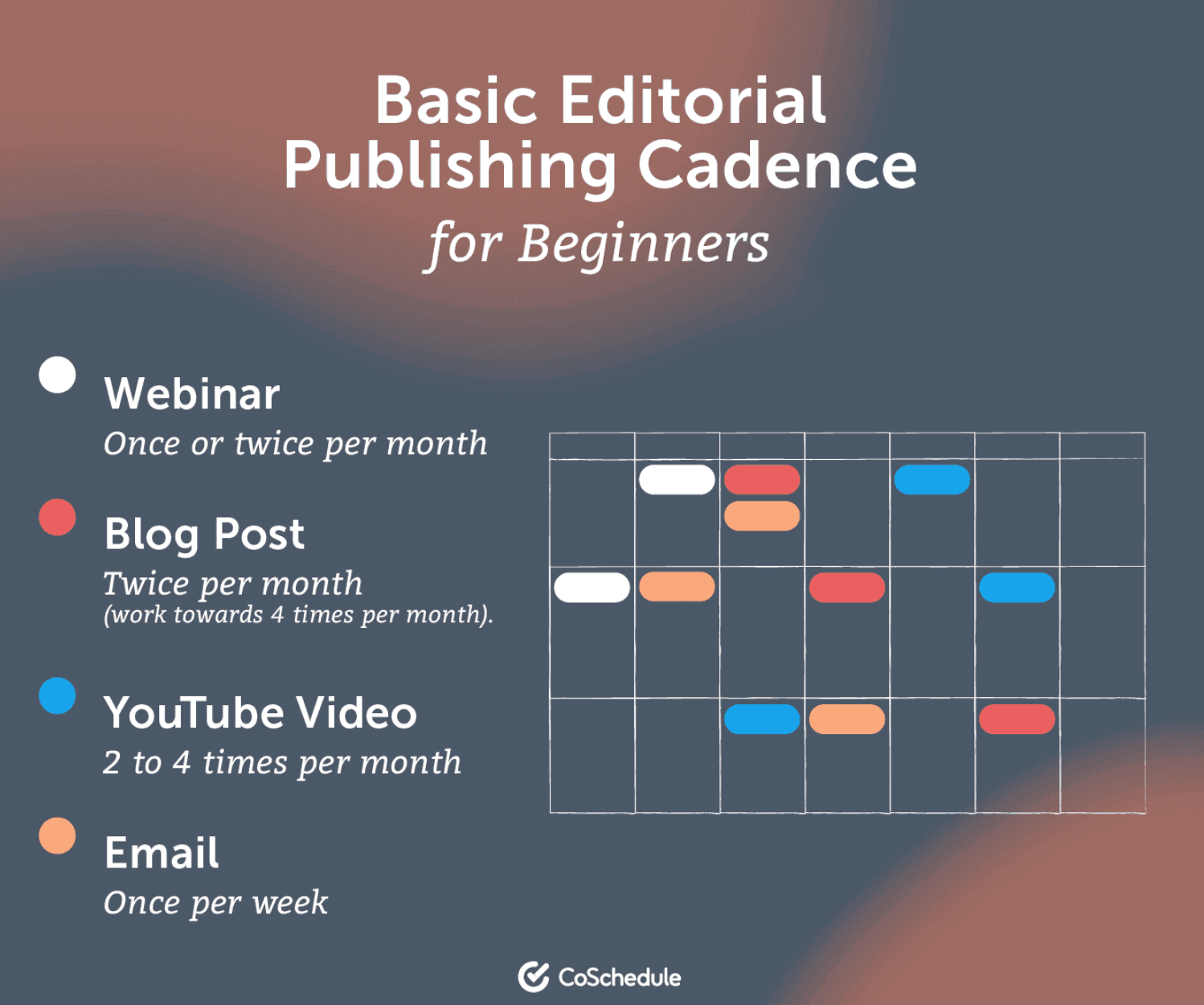
23. Utilize Guest Authors To Help Fill Gaps In Your Blog Schedule
Your content writers write and write and write….and still, it’s not enough to keep your blog schedule full.
Reaching out and having guest authors fill some of those gaps can allow your regular blog writers to get ahead in their content schedule and stay there. Plus you get the bonus of bringing the reputation of your guest writers to your blog.
Check out this blog post on how to handle guest bloggers the right way.
24. Guest Write For Other Blogs
Expand your content reach by guest blogging on other high ranking blogs in your industry. Guest blogging is an easy way to help increase your authority on industry topics and get your content in front of fresh eyes.
Kissmetrics has a great guide on how to manage your guest blogging.
25. Use Topic Clusters To Help Boost Your Search Traffic
Topic clusters are a newer SEO content strategy. They entail creating one piece of topical pillar content, supported by smaller pieces of content that fill out details around that topic.
Think about it like this:

Topic clusters work to increase the authority of your posts by creating a web of backlinks to your parent topic which gives it an extra SEO boost. The theory is that as your parent topic rises in rankings, so will your related content.
We broke down the whole process of building content around topic clusters on our blog.
26. Link Out To Authoritative Content
When you’re writing on topics, it’s easier to gain the trust of your audience by backing up your opinions with content from highly authoritative sources.
These sources should back up any facts and advice that you give your audience. It also helps give your content an extra boost because search engines will crawl through your content and place more weight on backlinks that search engines consider high authority.
This article from MOZ will show you how to find authoritative websites to support your content in a few easy steps.
27. Curate Content From Reputable Sources To Fill Gaps In Your Calendar
You’ve exhausted all your resources, and you still have gaps in your calendar to fill. Curating content from reputable sources can help you fill those gaps.
There’s a common misconception that curating content is somehow cheating or drives traffic away from your site. Both of those things are false.
Curating content from reputable sources is not cheating as long as you’re giving credit to the original authors every time you share said content. Now it may seem like driving traffic to another source is a bad idea. However, you can increase your own authority because you’re introducing your audience to information coming from another reputable source.
To learn how to curate content correctly, check out this blog post.
You can also download the CoSchedule Chrome extension which will let you find, curate and schedule content right from search results.
28. Repurpose Your Existing Content
As content marketers, we’re all looking for ways to get the most mileage out of our work — especially when we have limited time and resources. Try repurposing your content to reach more customers across channels.
If you have a piece of content that is going over well with your audience, don’t just publish and let it sit. Set it up to republish again and again to get it back in front of members of your audience who didn’t see it before.
“Yeah, but that takes so much time.”
It doesn’t have to though. Republishing your content can be as simple as updating or adding small pieces and scheduling it to be published again at a later date. At Coschedule these are the steps we take to republish our content:
- Step one: Re-read post and update outdated information or add and expand a topic.
- Step two: Create a working draft.
- Step three: Update graphics and social campaigns.
- Step four: Copy and paste the updated code over the original content.
- Step five: Schedule publish date.
That’s it, that’s all we do, and it makes republishing our best content a breeze.
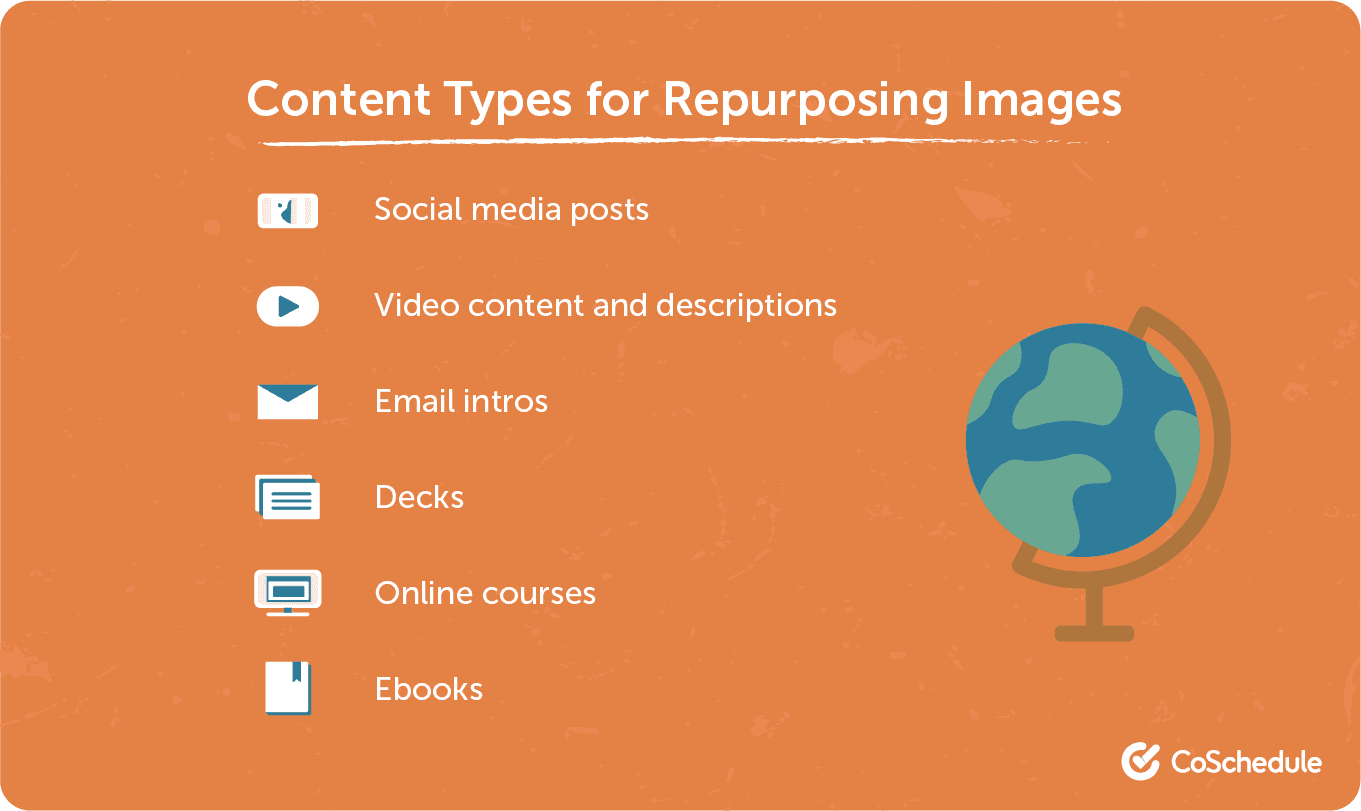
29. Make An Expert Roundup
An expert roundup works kind of like a subject matter expert interview — except on a broader scale. These articles gather responses and insight from experts in your industry on the topics and questions you choose.
Learn how to wow your readers with an expert roundup through our comprehensive blog post.
30. Craft Some Holiday Content
As you plan out your content calendar for the year, think about tailoring some of your topics to relevant holidays. In the marketing world, holidays go beyond Halloween and New Year’s — there are tons of novelty holidays out there that make great hooks.
We recently shared a list of social media marketing holidays that you can apply to a wide range of content types.
31. Start A Podcast
Looking to branch out and try to create different types of content? Try a podcast.
Seems like a crazy amount of work but trust us when we say the work is worth it. Almost 155 million Americans have listened to a podcast. That’s a huge audience that you could tap into.
Read this blog post to learn more about starting your podcast from someone who’s actually done it.
You can also let your podcast episodes inspire new content. Depending on how often you record them, you can either create complementary posts to your episodes, or recap them for those who haven’t listened yet.
We do this for every episode of the Actionable Marketing Podcast. Some things to keep in mind for every blog post that comes from your episodes:
- Make sure readers can listen to the podcast episode from the post.
- Include a transcript of your episode. Rev is a great resource to use if you don’t want to transcribe it yourself.
- Encourage people to subscribe to the podcast.
32. Create Actionable Content That Gives Instructions About How To Use Your Product
A lot of content just tells people what to do. So, stand out by showing your audience how to actually get stuff done.
Writing actionable content, especially if it’s step by step, can take a lot of time. I should know, I write that way all the time. However, this type of content gives your readers something to hook their teeth into, and it provides them with value.
After all, isn’t that why we write? To provide our readers with value.
Check out this blog post from Neil Patel about seven ways you can make your content more actionable.
33. Create Content On The Best Practices For Your Industry
Another common content marketing idea is publishing a list of best practices for your industry. These lists can cover a wide topic like “Best Practices for Social Media Marketing” or you can get into a niche subject like “the best practices for marketing on Facebook.”
Some things to keep in mind when you’re writing best practices content.
- Read what ranking content is included on their list. This is part of the skyscraper technique that we mentioned earlier. By including some of the same sub-heads but doing them better you’ll increase your chances of ranking.
- Don’t include three tips and stop. If you’re going to write a best practices list, go big or go home.
- Tell your audience how to do something. Don’t just give your audience advice, show them how to practice it.
34. Write Guides That Break Down Different Topics In Your Industry
Creating a guide on a topic in your industry is another idea to create solid content. These guides should be the most comprehensive and thorough content that your team has ever created.
They should not only tell your audience what they need to do; they should show them how to do it as well. That’s the theory that went into creating our Marketing Strategy Guide.
So what are the steps for creating these jaw-dropping guides?
- Step One: Choose a keyword and several related LSI keywords that your guide should cover.
- Step Two: Read the top ten pieces of content for every keyword that your guide targets and take notes on recurring questions or topics that you need to cover in your guide.
- Step Three: Research and gather data through surveying your target audience or reading reports from high authority sources (or both).
- Step Four: Compile all your information together in one easy to read guide.
- Step Five: Share it with the world.
35. Write A Case Study
Do you have a successful campaign, project, or client relationship that shows off what you can do for your customers? Write a case study about it! A case study breaks down how you solved a problem and the results you achieved.
As you’ll see in our guide to writing a case study, this content format typically includes a title, executive summary, subject, problem, solution, and results. If you hop on over to that blog post, you’ll get plenty of templates and inspiration.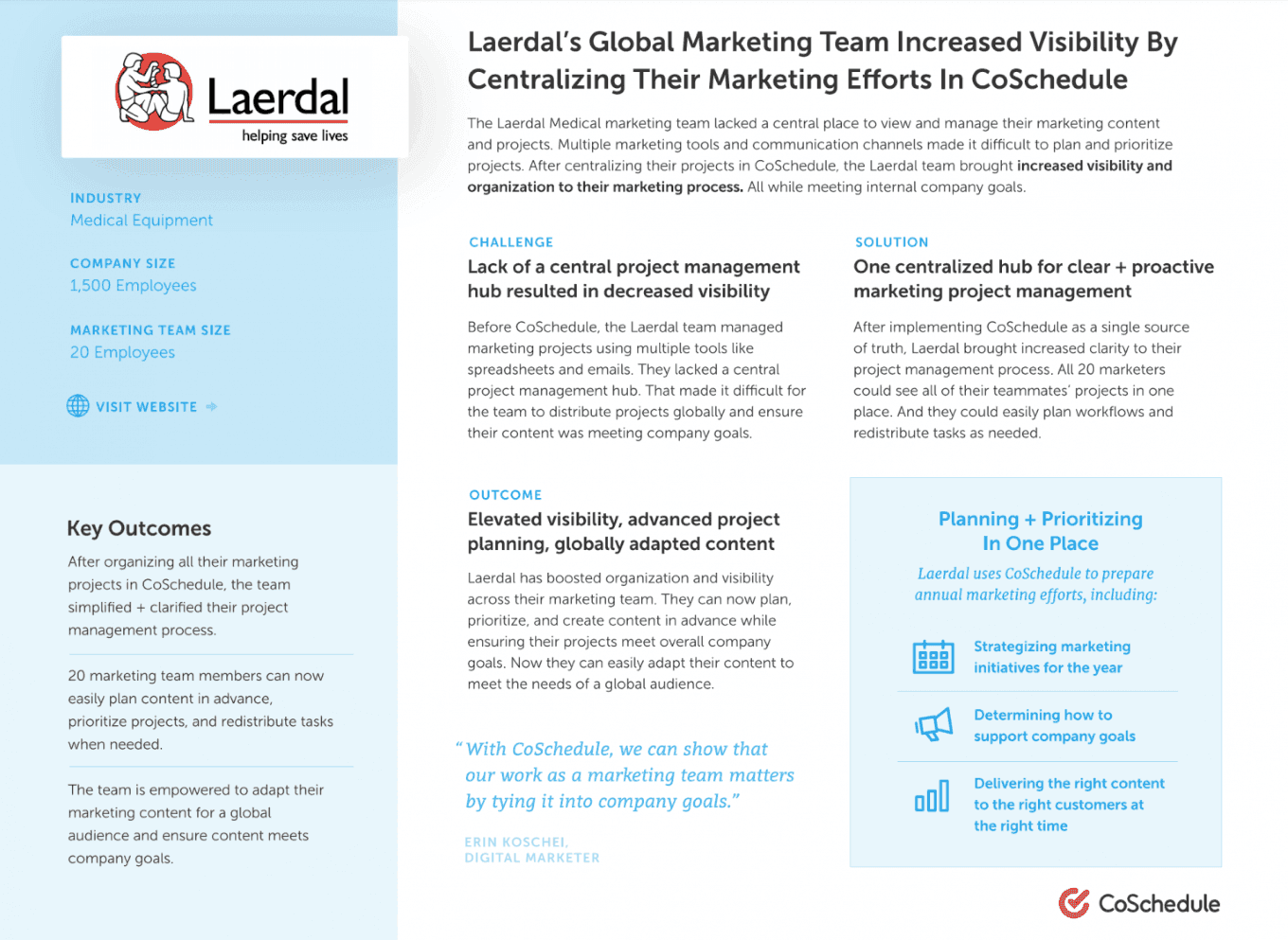
36. Create A White Paper People Will Actually Read
White papers don’t have to be boring. In fact, they can be a powerful tool in your content marketing strategy if done well.
White papers are research-based reports that dive into a specific topic. They’re based on facts (rather than opinions) and are great for presenting original research or summarizing information around a topic.
Learn how to craft the perfect white paper by reading this blog from CoSchedule’s Ben Sailer.
37. Show Your Product In Use
If your organization is trying to get your product into the shopping carts of your audience (online or in real life), help bring the sale home by showing how your product works.
We do this at CoSchedule all the time. We love being able to show our audience how our product works and different ways it can help make their marketing processes easier. (Hint, hint, nudge, nudge).
MarketingProfs explains how to create demos that your sales team will use, and customers will want to see in this blog post.
38. Create Courses To Teach Your Audience New Skills
If you haven’t made the connection already, teaching your audience how to do something should play a big role in your content marketing strategy.
To quote CoSchedule’s Head of Demand Generation Nathan: “People want to be shown how to do something.”

So creating a course is a great way to integrate that teachable aspect into your content. However, before you start uploading content keep these things in mind:
- Keep your course content evergreen. You don’t want to have to update content every few weeks.
- Be thorough in the knowledge you present. No one wants to waste their time or money on content that they already know. Make the course worthwhile for them.
- Think through what your objectives are for teaching said course. If your team has clear objectives for why you want to teach a course that will come across in your content. Don’t just teach a course to teach a course. Create content with a purpose.
Learn from the experts at Teachable about how to create an awesome course.
39. Create An Email Newsletter
59% of customers say that marketing emails influence their purchasing decisions.
Email newsletters inform subscribers of the latest updates or news about your product or service. Send newsletters to influence purchasing decisions and connect with your audience.
40. Host A Webinar
Engage your audience online with a webinar to inform listeners about your product or service. Webinars allow content marketers to attract new audiences and build relationships.
41. Build A Content Hub
A content hub is an interconnected collection of content focused on a single topic. Content hubs build topical authority, increase credibility, and grow SEO traffic.
CoSchedule breaks down keywords to create content hubs. Just take a look at the upper left side of this article:
42. Publish Your Original Research
Original research is the process of creating a research study to collect meaningful information.
Marketers note that research-based content has led to a 66% increase in social shares and 60% increase in backlinks.
Ways to Conduct Research for Content Marketing
- Put out fresh content without increasing your workload
- Surveys
- Focus Groups
- Interviews
- Aggregate Existing Research
- A/B Testing
43. Share User Generated Content
User-generated content (UGC) is any form of content created and shared by the brand’s users. 70% of consumers will consider UGC reviews or ratings before making a purchasing decision.
GoPro’s customers share UGC to participate in various challenges and promote GoPro’s products.
This piece was originally published December 1, 2020. It was updated December 3, 2021, April 11, 2022, and most recently April 2023.


